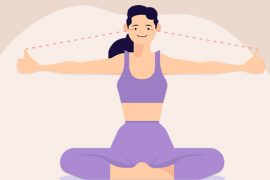As winter brings frigid temperatures, it becomes essential to combat the urge to hibernate indoors and maintain physical activity for overall well-being. Layering clothing and consuming nutrient-rich meals are crucial, but staying active should not be overlooked. Even in the coldest days, setting fitness goals becomes imperative to counter the allure of cozy blankets and tempting comfort foods. Despite the reluctance to steps outside in the chilly mornings, experts recommend indoor activities like walking, yoga, and aerobics to ensure a consistent exercise routine. Minimum Steps and Essential Exercises not only helps in staying warm but also contributes to maintaining a healthy lifestyle amidst the winter chill.
Indeed, colder temperatures can make outdoor activities less appealing, and indoor exercises can be a good alternative. Here’s a simplified guide for maintaining fitness during winter:
Minimum Steps:
While the ideal target is often set at minimum 10,000 steps per day, particularly in cold weather, it’s advisable to prioritize indoor exercises like brisk walking within the house or engaging in yoga. The low temperatures can lead to constricted arteries, making the heart work harder to maintain circulation. Recognizing the inclination to skip outdoor activities during winter, a more realistic goal of minimum 7,000 steps a day is recommended. This can be achieved through various indoor activities such as brisk walking, workouts, or yoga sessions. Regular physical activity not only helps alleviate the winter blues but also contributes to a healthy gut, promoting overall well-being throughout the colder months.
On challenging days when a full workout feels daunting, it’s recommended to engage in at least 20-30 minutes of walking or other physical activities to maintain a sense of energy and well-being. Adopting a pace of 100 steps per minute, one can achieve a minimum of 3,000 steps in this time frame, which serves as a suitable goal during the cold winter months. This moderate activity not only helps in staying active and energetic but also contributes to overall health and fitness, providing a manageable yet effective way to combat the winter lethargy.
Indoor Exercises:
- Brisk Walking in the House: Walk around your house at a brisk pace to keep your heart rate up. Set a timer for at least 30 minutes to ensure a good workout.
- Yoga: Practice yoga to improve flexibility, strength, and mental well-being. Include a mix of poses such as sun salutations, downward dog, and warrior poses.
Additional Indoor Activities:
- Bodyweight Exercises: Incorporate bodyweight exercises like squats, lunges, push-ups, and planks. Perform 3 sets of 10-15 repetitions for each exercise.
- Indoor Cycling: If you have a stationary bike, cycling is an excellent cardiovascular exercise. Aim for 20-30 minutes of cycling at a moderate intensity.
- Dance or Aerobic Workouts: Follow online dance or aerobic workout videos for a fun and effective indoor cardio session.
- Stair Climbing: If you have stairs, climb up and down to elevate your heart rate.
General Tips:
1. Home Safety:
- Heating Safety: Follow guidelines for space heaters and fireplaces to prevent fires and carbon monoxide poisoning. Use fire screens and keep flammable items away from heat sources.
- Supplies: Stock up on essential supplies like food, water, and medication for potential power outages or disruptions.
- Community Support: Check on vulnerable individuals, such as elderly neighbors, young children, and those with health conditions. Offer assistance if needed.
- Stay Informed: Keep track of weather forecasts and warnings for information on the severity and duration of cold weather.
2. Personal Well-being:
- Dress Appropriately: Layer clothing to trap heat and insulate the body. Wear a hat, gloves, and warm socks for protection.
- Indoor Activities: Engage in light indoor physical activities to keep warm and maintain circulation.
- Hydration: Stay hydrated by drinking plenty of fluids, despite the cold weather.
- Outdoor Activities: Be cautious with outdoor activities, especially winter sports. Take extra precautions and follow safety guidelines.
3. Home Insulation:
- Insulate Your Home: Ensure proper insulation to retain heat. Use weatherstripping and draft stoppers to prevent cold air from entering.
By adhering to these guidelines, you are not only safeguarding yourself but also promoting a sense of community care. Staying informed, prepared, and active is essential for a healthy and safe winter experience.
Disclaimer:
The information contained in this article is for educational and informational purposes only and is not intended as a health advice. We would ask you to consult a qualified professional or medical expert to gain additional knowledge before you choose to consume any product or perform any exercise.







